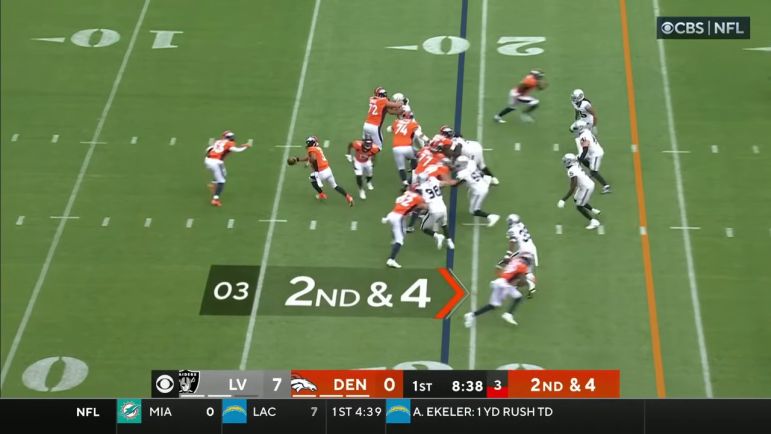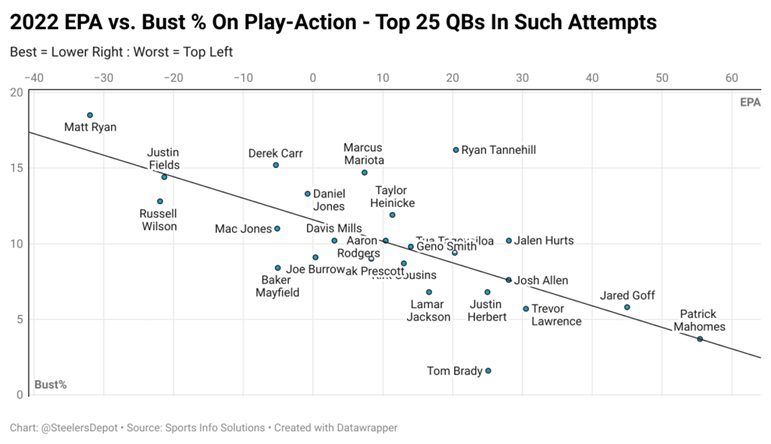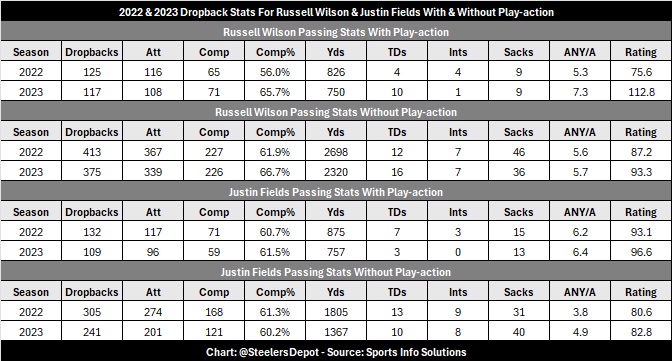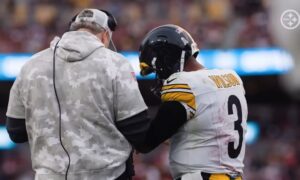I’ve been thinking quite a bit about how the Pittsburgh Steelers might utilize play-action during the 2024 season. That thought led me to want to dig a bit deeper into some related advanced analytics and stats for new quarterbacks Russell Wilson and Justin Fields.
Our very own Clayton Eckert somewhat addressed this subject in March in his study of the effectiveness of Wilson and Fields with and without play-action. That post, however, was mainly centered around Pro Football Focus grades for both. I, however, wanted to look at some advanced statistics and metrics for the two quarterbacks the last two seasons and here is what I found.
My first deep stat dive for play-action was for the 2023 regular season. Specifically, EPA totals and Bust Percentages on plays it was on. I graphed the results of the top 25 quarterbacks in play-action pass attempts in 2023.
In case you need a refresher, below are definitions from Sports Info Solutions as to what EPA and Bust Percentages are:
EPA: Expected Points Added; the total change in the offense’s Expected Points that came on passes thrown by the player
Bust %: The percentage of pass attempts that resulted in an EPA of less than minus-1 (i.e., a very unsuccessful play for the offense)
As you can see in the scatter plot below that uses data compiled from SIS, neither Wilson nor Fields ranks well when compared to the 25 leaders in play-action pass attempts in 2023. Both had negative EPA scores, and both had bust percentages nearing 15 percent.
After looking at the 2023 data, I wanted to compare it to the 2022 regular season, again using the top 25 quarterbacks in total play-action pass attempts. As you can see in this scatter plot below, Wilson and Fields also performed unfavorably that season.
With two seasons of data looked at, I thought it might be appropriate to look at both Wilson and Fields in the last two seasons when each used and didn’t use play-action. This time, I only plotted Wilson and Fields, and along with bust percentages, I used EPA per PA (Expected Points Added per Pass Attempt) on one axis. This resulted in needing four plot points for each quarterback.
When it comes to this particular scatter plot of the 2022 and 2023 data for attempts using play-action and not using it, you will notice that overall, both quarterbacks not only have bust percentages of nearly 15 percent or greater but also that they both have negative EPA/Att stats. Even so, the usage of play-action by both quarterbacks in both 2022 and 2023 ranked higher than when it wasn’t used, especially when it comes to bust percentages. Fields’ 2022 season, when not using play-action, is the big outlier on this chart.
So, what did the overall stats look like for both Wilson and Fields in 2022 and 2023 when using and not using play-action? I have those from SIS as well to pass along in this post, and they are below.
Of the four sets for each of Wilson and Fields, the thing that sticks out the most is Wilson not having a great play-action season in 2022. The four interceptions he had that season using play-action equaled his amount of touchdown passes thrown. The nine sacks also stuck out in 2022, and on just eight more dropbacks than he had in 2023 when using play-action. Wilson’s ANY/A (adjusted net yards per pass attempt) stat in 2022 when using play-action reflects the sacks, interceptions, and lack of touchdown passes. Wilson did rebound in 2023, at least in raw passing stats, when using play-action.
As for Fields, we have a lot more consistent raw stats for him over the course of the last two seasons for both using play-action and not using it. His jump in ANY/A when using play-action in the last two seasons is perhaps the most encouraging takeaway when merely looking at his raw drop-back stats. That noted, look at the number of sacks Fields has taken in each of the last two seasons when using play-action. Those certainly didn’t help his bust percentage, which the charts earlier in the post focused on. It does help explain those percentages, however.
Both Wilson and Fields were sacked way too often in the last two seasons, and the Steelers will likely work hard to change that in 2024.
All told, this study at least gives us a firm look at what Wilson and Fields have both done when using play-action the last two seasons. It will be interesting to compare the 2024 play-action stats to these in this post as the regular season progresses.












